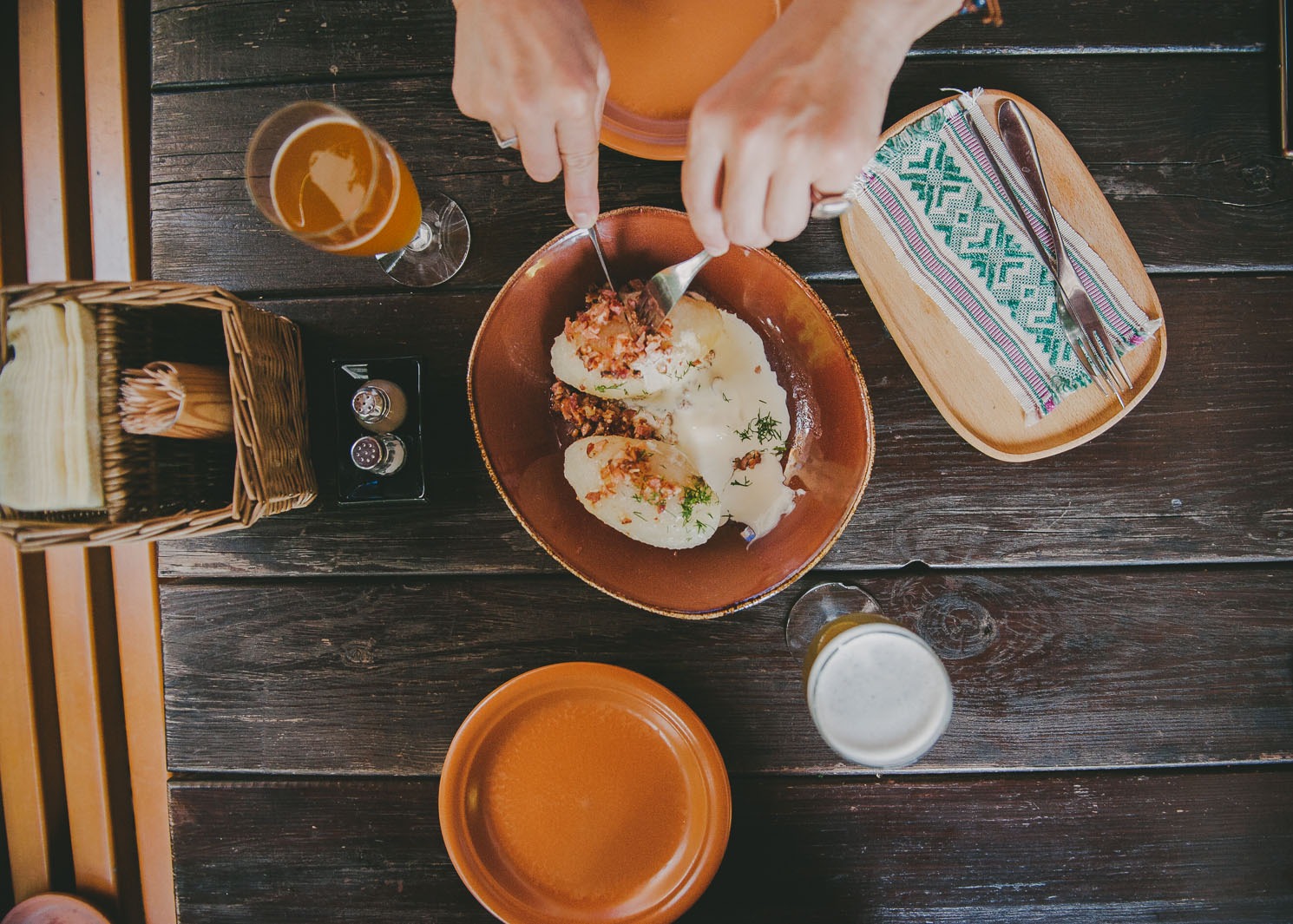
Travel. Some do it because they want to see history come to life, some thrive experiencing a different culture, for others it’s the thrill of adventure. No matter how you travel, one thing most of us can agree on is coming together to break bread and sinking our teeth into the best flavour a new destination has to offer. Well, if you’ve found yourself in Vilnius, wandering through the maze of churches that make Lithuania a living history book, thinking, ‘what am I going to eat for lunch?’, then have no fear my friends! We’ve got your back with our ultimate guide to everything you need to know about Lithuanian cuisine.
Speaking of bread, Lithuanians love and live by the three Bs: beer, bread, and basketball. While we won’t spend much time speaking about the latter, the former two are quite literally Lithuania’s bread and butter (we will just swap butter for some beer). This is not just any bread we are talking about here. Duona, or black rye bread, is as dense as it is naturally sweet, and commonly found in Baltic countries. The bread comes with a black rind making it look almost burnt, but do not let that fool you. It has simple ingredients — just rye flour, fermented with water — but a distinct, unexpected taste. Because of the importance of this bread in most Lithuanian diets, you’ll find it at just about any grocery store, bakery, or market; however we think Senamiesčio krautuvė, (a small market located in old town) has a little extra something that puts their loaf over the top. Grab some butter and salt or some white cheese and enjoy it for breakfast as Lithuanians do.
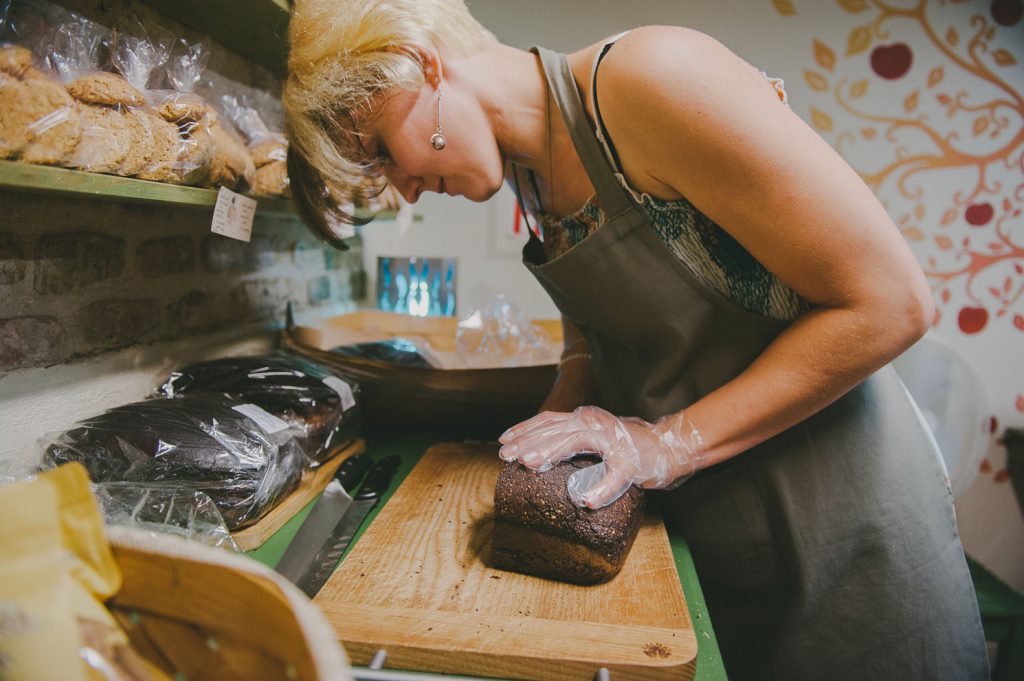
Photo by Alexandra Siebenthal
For any food odyssey of Lithuania, your first stop should be the market. I like to believe the best way to truly understand a place is through our stomachs, and there is no better way to accomplish just that than by exploring where the locals get their goods. Walk the corridors and absorb the atmosphere full of locals going about their business.
I did just this on my tour of Vilnius’ food scene with local guides Kestas and Vilija showing me the flavours to be found. We headed to Halės turgus, located right next to the train station, and which was full of friendly locals, who were all curious to know what I thought about Lithuania.
We first stopped at a stand that was bursting at the seams with wild berries, plums, cucumbers, and just about any other kind of produce you could want. It was manned by the daughters of local farmers whom Kestas and Vilija know personally. We sampled their hybrid strawberry-raspberry — a ‘strasberry’ — which had the most interesting texture and flavour. They described to us how the family grows everything on their property located just outside the city, as do most of the vendors at the markets.

Photo by Alexandra Siebenthal
As we continued on our market adventure with our senses leading the way, some unusual tree-like towers of all sizes caught my eye, almost looking more like a melted candle then something you would eat. No doubt noticing my inquisitive look, the baker mumbled something in Lithuanian and broke a piece off for me to try, revealing it’s poundcake taste. This dessert is called šakotis, or spitcake, and is made of butter, eggs, flour, sugar, and cream, and cooked by pouring the batter on a rotating spit over an open fire. Sounds very medieval, right? This exotic-looking pastry can be found at most Lithuanian celebrations, typically served covered in chocolate and ornamental flowers.

Photo by Alexandra Siebenthal
Another important staple in a Lithuanian diet: the mighty pig. It’s no secret that Baltic countries have a long history of meat-heavy diets, especially pork, and Lithuania it is no exception. Most of that tradition stems from rural areas where they found creative ways to use the entire animal, as they couldn’t afford to throw anything edible away. While we all love pork-stuffed cabbage rolls and bacon, there are other traditional dishes that might require a more adventurous appetite (frankly, I think this is the best part about travelling!). One dish, known as skilandis, is pig’s stomach filled with pork meat and dried into a sausage. Or how about some pig’s ear? Or pork leg? (Typically cooked for hours until the meat is nearly falling off the bone.) These all have an acquired texture, sure, but these Lithuanian dishes are as classic as they come.
As we browsed the cases of freshly butchered meats, Vilija asked the lady working the counter for a piece of what looked like white bacon, and handed it to me. She spoke of the importance of this little piece of meat, explaining how tourists are often off-put by it. I bit into the chewy flesh, revealing a delicious smoked bacon taste. This Lithuanian staple is known as lašiniai, or non-rendered pork lard, and it’s commonly spread on that delicious black bread we described earlier and eaten as a filling snack. I think it’s pretty tasty, so long as meat is your kind of thing.
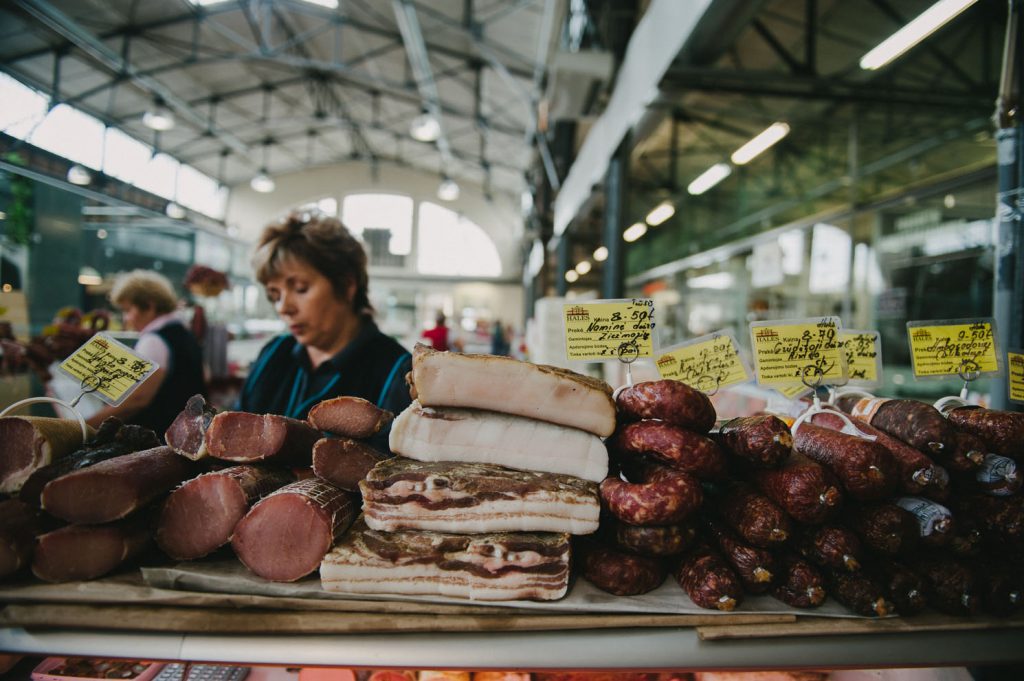
Photo by Alexandra Siebenthal
With Lithuania’s long-standing love affair with pork, young entrepreneurs are certainly taking advantage with a few trendy twists on tradition. One place that comes to mind would be Keulė Rūkė. This modern BBQ joint caters to the young and self-proclaimed “foodie” crowd, serving up slow-cooked pork as well as some Alus from Raudonu Plytu (a local craft brewery offering beers with quirky names like Mustache of Boatswain and Zombie in Tundra). While the interior is a bit small, the courtyard is filled with mismatched chairs and re-purposed furniture (including a seat made out of a bathtub, cut in half), so it’s got a quirky, underground atmosphere for while you’re chowing down on some of the best pork in town. Be forewarned, though, there will likely be a line out the door and they only make a limited batch of the good stuff each day.

Photo by Alexandra Siebenthal
While exploring the markets is a great way to understand local culture, the true heart of Lithuanian cuisine can only be found in one place: in households across the country. And while you might not have the opportunity to share a meal in a Lithuanian home, that shouldn’t stop you from eating like you are in one. There are a few simple things you can pick up at the market, and you can have yourself a true Lithuanian meal in your home away from home.
With its hearty fare and focus on meat and potatoes, Baltic food has a carnivorous reputation. But while these dishes definitely play an important role in Lithuanian cuisine, not everything is so dense or calorie-filled. One thing Vilija swears by is cucumbers, white cheese, and honey — something you won’t find in any restaurant. Slice up the cucumbers and cheese and slather with some local honey and you have a refreshing, healthy starter to rev up your appetite.

Photo by Alexandra Siebenthal
Another crucial element to the Lithuanian diet is the mushroom. Many countries across Europe have a history of foraging for wild fungi in the forests, particularly in rural areas where mushrooms grow like weeds and can be collected for free. During harsher economic climates, mushrooms were crucial to the survival of villages at a time when meat was expensive. But if you are looking for true Baltic mushrooms in restaurants, you won’t find them. What you’ll get is not what locals consider real mushrooms, but rather champignons. You can only typically find true boletus mushrooms fresh in the markets in autumn — otherwise they are typically dried, and made into a soup with potatoes and onions.
While we are still on the topic of markets, another must-not-miss for you organic-loving foodies is the Tymo Markets (open Tuesdays 10am to 3:30pm and Thursdays 4pm to 8pm). This market offers up a more modern take on Lithuanian fare and is the place to get anything organic and health-focused. I sampled some delicious gluten-free cookies naturally sweetened with honey and orange peel, white cheese covered in hemp seeds and lightly pan-fried in oil, and some delicious smoked river fish served cold — just beware of the bones! This is a place to let your appetite truly explore modern Lithuanian cuisine while supporting the locals experimenting with what that idea means.

Photo by Alexandra Siebenthal
Perhaps the most quintessential part of Lithuanian cuisine is the dumplings, or cepelinai, which means ‘Zeppelin’ for their blimp-like shape. What could be better than a dumpling made out of grated potatoes, stuffed with meat, cooked for hours and hours, then served smothered in a sour cream sauce flavoured with bacon and pork rinds? Nothing. That’s what we thought, too, when sinking our teeth into this Lithuanian delight. Now, if you ask who makes the best, the answer will always be someone’s grandmother. However, in the likelihood you will not be sharing meals with anyone’s Lithuanian grandma, rest easy knowing you can get your fill at Šnekutis, a quirky pub in Užupis meaning ‘the chatty man.’ Rumour has it they really do have the best in town, but we know this could always be up for debate. If you wish to stay closer to old town, Fortas serves an excellent plate as well.
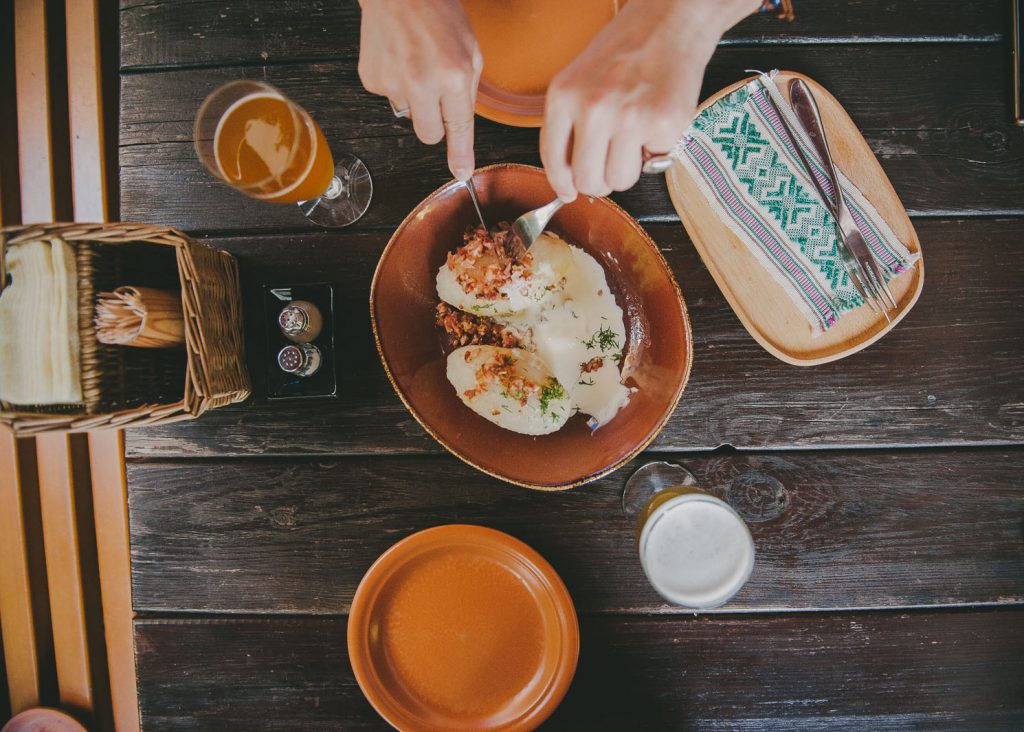
Photo by Alexandra Siebenthal
Another cornerstone of Baltic food is buckwheat. The country’s lon standing history with this seed (it’s not actually wheat) comes from the 7th-century Byzantine Greeks. It’s typically eaten as a porridge for breakfast or as my favourite: in pancakes. Buckwheat pancakes tend to be known as merely a healthier option for those with an aversion to gluten, but it’s the earthy taste that has a place in my heart. It’s certainly not exclusive to breakfast, though, and these pancakes can be enjoyed anytime of day. Places such Kitchen offer buckwheat pancakes smothered in blueberry sauce and topped with curd cheese with a hip, minimalist ambiance and informal vibe, with communal tables making it the place I want to be enjoying brunch on Saturday morning.
Another major influence over the Lithuanian culinary scene came during the Soviet reign of the Baltics. Naturally, 50 years of oppressive occupation will have effects on a culture’s diet. With it came the deficit of meat as well as many other things, and thus families had to get creative in ways to feed their families. Thus the coin of čeburekai, a meat-filled turnover, and popular to serve guests — a symbol of treating them with dignity and showing you were not lacking anything. While this dish has a dark past and might not be the healthiest option, I must admit it’s pretty delicious.
Often on our travels, we come across a dish or particular item of food that is heavily linked to a specific location. In Lithuania, such a dish can only truly be enjoyed from a fortress located about 30 kilometres outside Vilnius. The village of Trakai boasts a UNESCO-preserved medieval fortress giving it its namesake, built on an island in the middle of a lake. One of the more incredible things about this village — beyond the historical landmark — is the preservation of the Karaites, a community that has survived for over 600 years with their own traditions, beliefs, customs, language, and you guessed it, culinary delights. These people come from the ancient Turkic tribes and are responsible for the genesis of the kibinai. This crescent-shaped pastry is packed with meat stewed in onions and baked to perfection. Traditionally, it is stuffed with mutton, however modern ones can be found with all sorts of meats and vegetable combinations. Add a little bit of broth to compliment its perfectly crispy exterior and you’ve got melt-in-your-mouth goodness. This is one medieval treat you will not want to miss and the fortress isn’t so bad, either.
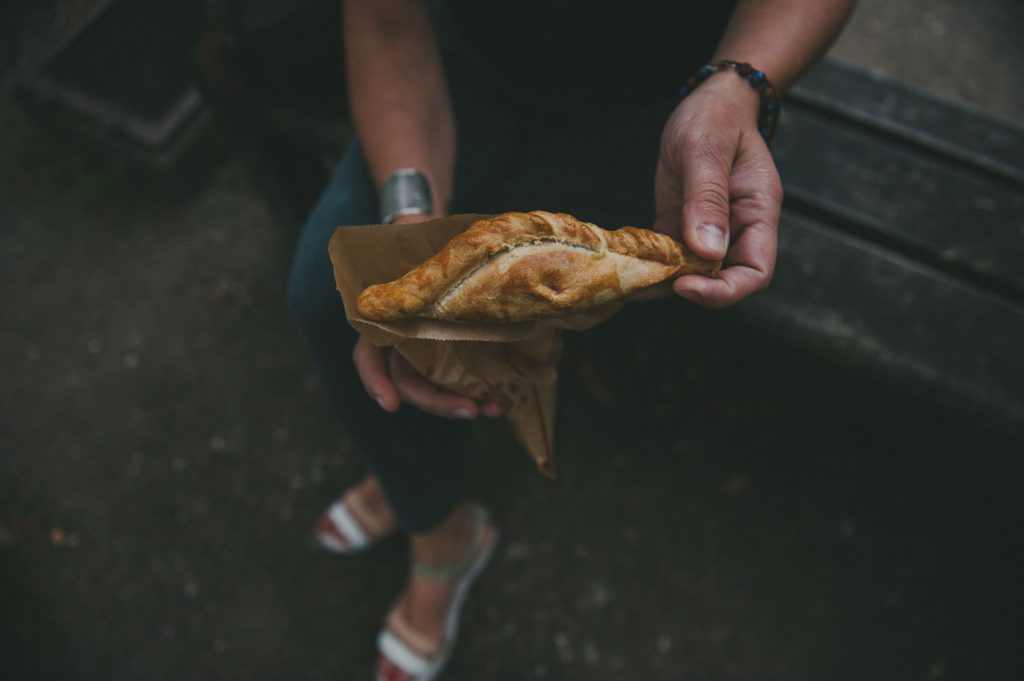
Photo by Alexandra Siebenthal
Take your medieval cuisine expedition one step further with some traditional midus, or what we know as mead. This liquor has roots dating back to the 11th century when it was concocted from honey gathered from wild bee hives and served as a common table drink. Today, traditional mead in Lithuania packs a major punch. Despite the high alcohol content, this honey liquor maintains a sweetness that cuts its harsh bite, becoming the perfect aperitif after an indulgent meal.

Photo by Alexandra Siebenthal
In preparation for my culinary explorations throughout Vilnius, one Google search revealed countless meat-centered options and a contrasting, bright-pink hued soup that caught my eye instantly. By pink, we are talking the colour synonymous with a medicine travellers around the globe know all too well: Pepto-Bismol. While some might find this shade completely off-putting (as it isn’t exactly a colour of any edible fruit or vegetable that I could think of), it is exactly what you want on a hot summer’s day. Think gazpacho, but with the perfect blend of beetroot and kefir, giving it that vibrant pink colour. Add a little cucumber, chives, dill, and a hard boiled egg and you’ve got šaltibarščiai. It’s served with a few boiled potatoes, making it a little more hearty. We think this soup is perfect when we need a break from all the meat-heavy deliciousness in which we’ve been overindulging.
Catching Vilnius in the winter months? Šaltibarščiai is still available in hot form: barščiai. Popular in most Baltic countries, it’s served up in a similar fashion, only piping hot to help cope with the cold winter months.

Photo by Alexandra Siebenthal
Finally, we can’t forget something tasty to drink, so you can wash down all this food, and of course it would not be the ultimate guide to Lithuanian cuisine without acknowledging locals’ relationship to beer, as Lithuania is one of the countries in Europe with a tradition of drinking its own style of beer. Just as the Czechs have their crystal-clear pilsners, Germans have their doppel bocks and hefeweizens, and Belgians have their sour ales and saisons, Lithuania has its own distinct brew — but there is no real answer to just what that is.
Typically, a true Lithuanian beer is a farmhouse ale, with all the ingredients Lithuania-grown and the farmers using their own yeast. (This brings a whole new meaning to the term homegrown craft brews.) But this home-brewing culture has created an endless amount of styles with no real consistency or name, making Lithuania the last great beer frontier. So just where can you try this good stuff? Stop into Bambalynė, a basement bar with a variety of Lithuanian brews on tap. Here’s hoping you let that beer palate run as wild as the yeast that made them!
And what is a beer without some beer snacks? Well, it’s still delicious beer, but we think it’s even better enjoyed with some kepta duona to get the proper Lithuanian beer drinking experience. Just about anywhere there is beer in Lithuania, these guys will follow: that delicious black bread, fried in oil, then rubbed with fresh garlic. Think French fries made from rye bread. Often times they come smothered in melted cheese or with a side of mayonnaise for dipping to your heart’s content. Like we need to convince you more.
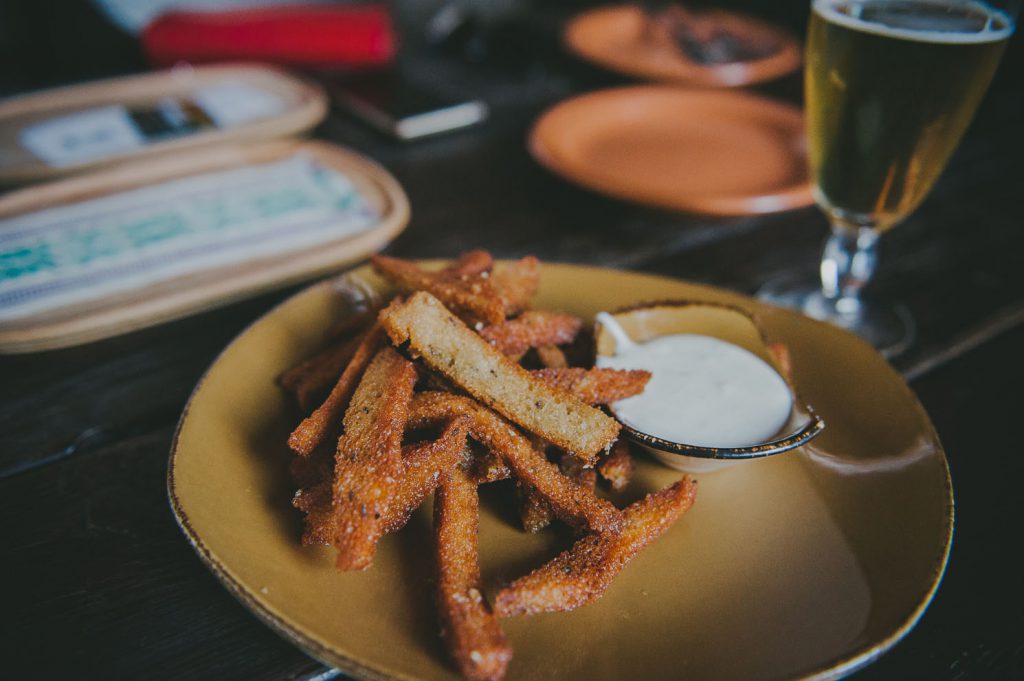
Photo by Alexandra Siebenthal
And while we can talk your ear off about Lithuanian beer, we must also include kvass. This drink is a naturally fermented beverage made from that black bread we obsessed over plus some yeast, sugar, and raisins. It’s rich and rather sweet to taste, and a staple of Lithuania. While it does not have much alcohol (a mere 0.5% to 1%) it is rich in vitamin B, and exactly what you need to go with all that cepelinai.
And finally, now that you have eaten your way around Vilnius, we don’t want you to leave without catering to that sweet tooth we know you have. One treat most Lithuanians have nostalgic feelings for is tinginys, meaning ‘the lazy one,’ made of biscuits or crackers, cocoa, butter, sugar, and solidified milk. Its namesake comes from how simple it is to make, and we know that sometimes the simplest things are the best things. It’s full of velvety, chocolate goodness with the perfect amount of sweetness. I stopped into Birzu Duona in Uzupis for one and washed it down with a cafe latte — the perfect companion.

Photo by Alexandra Siebenthal
So there you have it, our definitive guide covering everything you need to know about Lithuanian cuisine. We wish you (and your appetite) happy explorations of Vilnius and beyond! Skanaus (or enjoy), my friends.